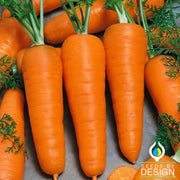Growing Non-GMO Red Core Chantenay Carrot Vegetable Seeds
How to Red Core Chantenay Carrot from Seed
Carrot is a cool weather crop best sown directly in early spring or late fall. Like many root vegetables, carrot does not transplant well and should be directly sown. Plant 2-3 seeds ¼" deep and 1-2" apart in very loose, well-tilled, and well-drained soil in full sun. Seeds germinate in 14-21 days, thinning back to 1 plant every 2" as true leaves establish. Avoid using nitrogen-rich fertilizers which are known to cause growth abnormalities.
These seeds can be sowed directly outdoors in the spring for a late summer harvest. Choose an area with full sun and soil that is sandy, loose, and moist. The roots should be able to easily grow straight downward, so remove all obstacles such as rocks from it before sowing the seeds to avoid crooked roots. The soil should have a pH level of around seven. Each seed should be planted half an inch deep in the soil, as soon as it can be worked. Keep four inches between each plant and nine to sixteen inches between each row. After around sixty eight days, the Chantenay Red Core carrots will be fully mature and ready for harvest.
Red Core Chantenay Carrot in the Vegetable Garden
Carrot is a sugary sweet root vegetable second only to the beet in overall sugar content. Carrot is one of the easiest, quickest, and most satisfying garden crops and lends itself to as many savory dishes as it does sweet. Although considered a predominantly orange vegetable, the carrot is available in a wide selection of exquisite heirloom colors such as red, purple, yellow, and white. Carrots can be sown every couple weeks for successive season-long harvesting.
Harvesting Red Core Chantenay Carrots
Most varieties of carrot are ready for harvest about 70-80 days from sowing, while smaller varieties such as Parisian are ready a few weeks sooner. Regardless of color, carrots are usually ripe for harvest when the root begins to show above soil.
A sandy and well-tilled garden will help in harvesting, providing a loose soil to safely uproot the carrot crop without the need for tools. For more hardened soils, use a specialized hand cultivator or garden hori-hori knife.
About Red Core Chantenay Carrot Garden Seeds
From the Chantenay region of France, Chantenay is an old-world favorite grown for denser, stubbier roots.
A Golden orange carrot that is 5"-7" long and 2" in diameter. Chantenay red cored is known for its ability to handle relatively heavy soils and still produce. Resist splitting and forking. Reliable. Chantenay red cored makes a good storage carrot.
1932 Dupoy & Ferguson Seed Company says...
"The tops are shorter and the foliage finer cut than regular Chantenay. However the tops are not brittle and are strong enough to bunch easily. The roots are refined in appearance with small collars, are evenly stumped and have very small rat-tails. The surface of the root is smooth and free from large eyes and side rootlets. The exterior color is a rich orange, decidedly deeper than the ordinary run of Chantenay. The cores are small and nearly the same as the flesh. The roots grow about 5.5-6" long, are 2-2.5" in diameter at the shoulder, and are broad at the bottom, often being 1.25-1.5" just above the rat tail. It possesses all the advantages attributed to Nantes for slicing or for dicing in soups and salads. For market gardener and shipper."
1936 James Seed Company says...
"One of the best general purpose carrots. Roots are slightly tapering and abruptly stump rooted, 6 inches long and 2 1/4 inches through at the top. The core is deep orange, the same color as the flesh. Sow early in rows 18 inches apart, thin to 2 to 3 inches apart in the row, cultivate often and keep clean of all weeds. For late use, sow until the middle of June. Also known as Red Cored."
1937 MacFayden Seed Company says...
"Quite and improvement. Developed and first introduced by Ferry-Morse. A desirable Chantenay with good interior color; valuable for canners and market gardeners. In our experience Red Cored Chantenay is not as uniform as strains of the straight Chantenay variety."
Recommended by the Following State Universities or Ag Extension Offices as a variety that performs well for their region. FL, IL, OR, TX






